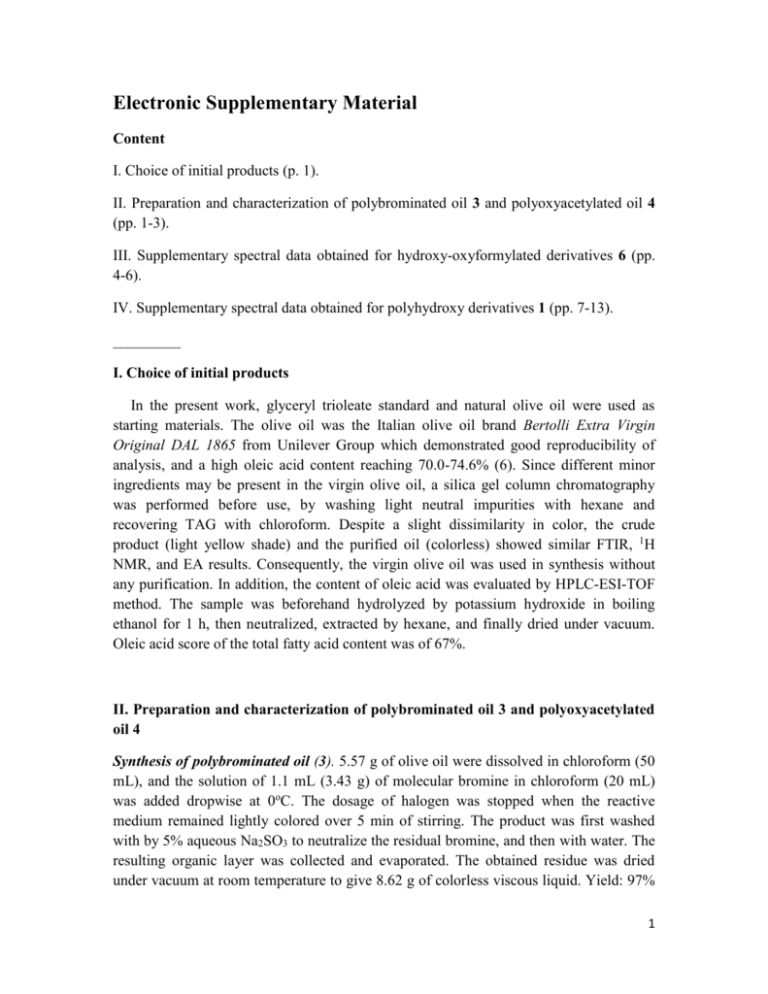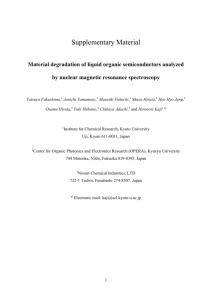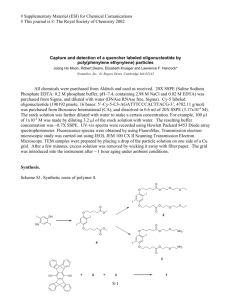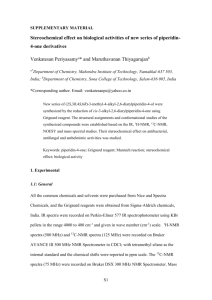Electronic Supplementary Material
advertisement

Electronic Supplementary Material Content I. Choice of initial products (p. 1). II. Preparation and characterization of polybrominated oil 3 and polyoxyacetylated oil 4 (pp. 1-3). III. Supplementary spectral data obtained for hydroxy-oxyformylated derivatives 6 (pp. 4-6). IV. Supplementary spectral data obtained for polyhydroxy derivatives 1 (pp. 7-13). _________ I. Choice of initial products In the present work, glyceryl trioleate standard and natural olive oil were used as starting materials. The olive oil was the Italian olive oil brand Bertolli Extra Virgin Original DAL 1865 from Unilever Group which demonstrated good reproducibility of analysis, and a high oleic acid content reaching 70.0-74.6% (6). Since different minor ingredients may be present in the virgin olive oil, a silica gel column chromatography was performed before use, by washing light neutral impurities with hexane and recovering TAG with chloroform. Despite a slight dissimilarity in color, the crude product (light yellow shade) and the purified oil (colorless) showed similar FTIR, 1H NMR, and EA results. Consequently, the virgin olive oil was used in synthesis without any purification. In addition, the content of oleic acid was evaluated by HPLC-ESI-TOF method. The sample was beforehand hydrolyzed by potassium hydroxide in boiling ethanol for 1 h, then neutralized, extracted by hexane, and finally dried under vacuum. Oleic acid score of the total fatty acid content was of 67%. II. Preparation and characterization of polybrominated oil 3 and polyoxyacetylated oil 4 Synthesis of polybrominated oil (3). 5.57 g of olive oil were dissolved in chloroform (50 mL), and the solution of 1.1 mL (3.43 g) of molecular bromine in chloroform (20 mL) was added dropwise at 0oC. The dosage of halogen was stopped when the reactive medium remained lightly colored over 5 min of stirring. The product was first washed with by 5% aqueous Na2SO3 to neutralize the residual bromine, and then with water. The resulting organic layer was collected and evaporated. The obtained residue was dried under vacuum at room temperature to give 8.62 g of colorless viscous liquid. Yield: 97% 1 (calculated on the pure triolein basis). 1H NMR (δ, ppm): 5.25 (s, 1H, RO-CH2-C(OR)HCH2-OR), 4.29-4.25 (m, 4H, RO-CH2-C(OR)H-CH2-OR), 4.19-4.17 (m, 2H, H-C-Br), 4.14-4.09 (m, 4H, RO-CH2-C(OR)H-CH2-OR), 2.29 (m, 6H, ROC(O)-CH2-R), 2.02 (m, 12H, -CH2-CH(Br)-), 1.81 (m, 12H, -CH2-CH(Br)-), 1.58 (s, 6H, ROC(O)-CH2-CH2-R), 1.30-1.22 (m, nH, -CH2-), 0.87 (m, 9H, -CH3). 13C NMR (δ, ppm, 100.61 MHz): 174.01, 173.60, 69.74, 69.74, 62.93, 60.52, 35.66, 34.81, 32.71, 30.53, 30.19, 29.79, 29.66, 28.59, 25.63, 23.48. FTIR (νmin, cm-1): 2923, 2853 (C-H), 1741 (-O-C(O)-), 1459 (–CH3 and >CH2), 1377 (–CH3), 1239, 1160 (C-O), 1119, 1097, 723(>CH2), 548 (C-Br). EA (%): calculated for triolein derivative 3 (C57H104O6Br6) C 50.16, H 7.68; found C 51.73, H 7.88. Synthesis of polyoxyacetylated oil (4). A mixture containing 40 mL of DMF and 4.00 g of sodium acetate was dried by Dean-Stark azeotropic method with toluene (100 mL). The toluene was then evaporated under vacuum and 0.96 g of polybrominated product 3 was added. The obtained mixture was stirred at 130-135oC for 48 h, and the resulting solution was cooled to room temperature. The residue was extracted with hexane (70 mL) and then washed with water (50 mL). After evaporation, the crude product was purified by silica gel chromatography (CHCl3; control by TLC; preparative eluent: CHCl3methanol 20:1). The collected solution was evaporated to give 0.39 g of colorless viscous oil (45% yield based on starting pure triolein). 1H NMR (δ, ppm): 5.65-5.58 (m, 6H, HC(OAc)-HC(OAc)-), 5.28 (s, 1H, RO-CH2-C(OR)H-CH2-OR), 4.23-4.09 (m, 4H, ROCH2-C(OR)H-CH2-OR), 2.42 (m, 6H, -CH2-HC(OAc)-), 2.36 (m, 18 H, -O-C(O)-CH3), 2.33 (m, 6H, ROC(O)-CH2-R), 2.16 (m, 6H, -CH2-HC(OAc)-), 2.04 (m, 12H, -CH2-CH2HC(OAc)-), 1.63 (s, 6H, ROC(O)-CH2-CH2-R), 1.56 (m, 6H, ROC(O)-CH2-CH2-R), 1.32-1.25 (m, nH, -CH2-), 0.90 (m, 9H, -CH3). 13C NMR (δ, ppm, 100.61 MHz): 174.01, 62.94, 42.04, 34.88, 32.75, 30.52, 30.06, 25.69, 23.52, 14.93. FTIR (νmin, cm-1): 2923, 2854 (C-H), 1743 (-O-C(O)-), 1459 (–CH3 and >CH2), 1378 (–CH3), 1238, 1159 (C-O), 1119, 1097, 987, 723 (>CH2). EA (%): calculated for triolein derivative 4 (C69H122O18) C 66.85, H 9.92; found C 65.69, H 10.13. 2 FIG. S1. 1H NMR spectra (CDCl3, 300 MHz) of the initial olive oil (A), brominated product 3 (B), and polyacetyl derivative 4 (C). 3 III. Supplementary spectral data obtained for hydroxy-oxyformylated derivatives 6 FIG. S2. 1H NMR spectrum (CDCl3, 300 MHz) of the hydroxy-oxyformyl 6 derivative obtained from natural olive oil. 4 FIG. S3. 13C NMR spectrum (CDCl3, 75.44 MHz) of the hydroxy-oxyformyl derivative 6 obtained from natural olive oil. FIG. S4. FTIR spectrum (ATR on ZnSe) of the hydroxy-oxyformyl derivative 6 obtained from natural olive oil. 5 FIG. S5. 1H/1H NMR NOESY spectrum (CDCl3, 300 MHz) of the hydroxy-oxyformyl derivative 6 obtained from triolein. 6 IV. Supplementary spectral data obtained for polyhydroxy derivatives 1 FIG. S6. 1H NMR spectrum (CDCl3, 300 MHz) of the polyhydroxy derivative 1 obtained from natural olive oil. 7 FIG. S7. 13C NMR spectrum (CDCl3, 75.44 MHz) of the polyhydroxy derivative 1 obtained from natural olive oil. FIG. S8. FTIR spectra (ATR on ZnSe) of the polyhydroxy derivative 1 obtained from natural olive oil. 8 FIG. S9. 1H/1H NMR NOESY spectrum (CDCl3, 300 MHz) of the polyhydroxy derivative 1 obtained from triolein (in squares: signals of interaction between hydroxymethine (>C(OH)-H) and hydroxyl (>C(OH)-H) protons). 9 FIG. S10. 1H/1H NMR NOESY spectrum (CDCl3, 300 MHz) of the erythro-polyhydroxy derivative obtained by interaction between triolein and OsO4 followed by basic hydrolysis with KOH in pyridine and extraction by hexane. 10 FIG. S11. 1H/1H NMR NOESY spectrum (CDCl3, 300 MHz) of the erythro-polyhydroxy derivative obtained by interaction between triolein and KMnO4 without transfer phase catalyst (spectrum corresponds to initial triolein). 11 1.615 1.803 2.017 2.312 2.445 2.463 2.724 4.152 4.168 4.287 5.263 5.266 5.340 5.343 150000000 100000000 50000000 0 10.0 5.0 ppm (t1) FIG. S12. 1H NMR spectrum (CDCl3, 300 MHz) of the erythro-polyhydroxy derivative obtained by interaction between triolein and KMnO4 in the presence of 15-Crown-5. 12 a. b. c. FIG. S13. HPLC-ESI-TOF (negative mode) chromatogram (a) with mass spectrum of main peak (b), and MALDI-TOF (positive mode) spectrum of the final deformylated polyol 1 obtained from the olive oil after 5.5 h of acidic hydrolysis in acetone (c). 13









